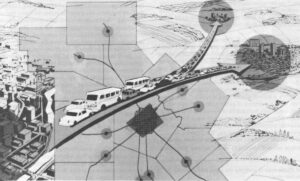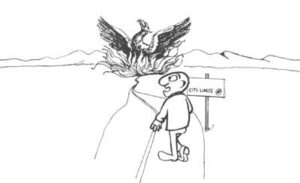Ed Zuckerman
- 1981

Fellowship Title:
- Planning for Nuclear War
Fellowship Year:
- 1981

Debating Doomsday
The two men came together in the lobby of a Virginia conference center and started to argue about the effects of nuclear war. One of them, young, bearded and earnest, was a member of Physicians for Social Responsibility, an organization which has been spreading the message that a nuclear war would destroy “the economic, ecologic, and social fabric on which human life depends” and that “there is no effective civil defense” against nuclear attack. The second man, older and balder but equally earnest, was an employee of the Federal Emergency Management Agency, which is in charge of planning civil defense for nuclear war and has been spreading the message that “reasonable steps” can “greatly mitigate…the deaths and suffering that would result from a nuclear disaster.” The two men were finding little common ground. “You can say 30 million people will be saved by civil defense,” the young doctor said scornfully to the civil servant, “but if there’s any evidence for it you’d be able to get at least one physician to go on record and

The Last Picture Show
WASHINGTON, DC–The last film millions of Americans may ever see is a 27-minute animation called “Protection in the Nuclear Age.” Produced by the Federal Civil Defense Agency, the film is available for public viewing now, but it is specifically designed to be shown on television if a nuclear attack against the United States is ever considered likely. “We live in a world of tension and conflict…” the film’s narration begins, as a picture of the earth floating peacefully in space appears on the screen. “We must therefore face the hard reality that someday a nuclear attack against the United States could occur.” To prepare viewers for that day, the film offers a sample and a description of the siren signal (“a 3-to 5-minute wavering sound”) that means enemy missiles are on their way. The film tells people how to react (“take cover…take a battery-powered radio with you”), includes a brief tutorial on the effects of nuclear detonations, and offers instructions for the construction of improvised fallout shelters. “The greatest danger,” the narration concludes, “is hopelessness–the

War Through the Looking Glass
WHITE SANDS MISSILE RANGE, New Mexico–On a warm and clear autumn day in the desert the Spanish called Jornada del Muerto–the Trail of Death–the only cloud in the sky has the shape of a mushroom. Just three-and-a-half miles from the spot where the world’s first atomic bomb was tested in the final days of World War II, the Defense Nuclear Agency has detonated a mock nuclear explosion. There is no radioactive material involved in this blast. The fuel was not plutonium but 24,790 50-pound sacks of ammonium nitrate, a common fertilizer, held together with 1000 pounds of glue and doused with diesel fuel oil. At its hottest spots, where the heat of the exploding fertilizer was augmented by flaming jets of liquid oxygen and powdered aluminum, the DNA test never exceeded 3500 degrees, compared with the millions of degrees of a nuclear blast. By treaty, this test could not be a nuclear blast. While the United States explodes real nuclear weapons at a rate of more than one a month at its underground test site

Mushroom
WASHINGTON, DC–There’s nothing ambiguous about the modern office complex in the basement of the Department of Health and Human Service’s Hubert Humphrey Building. A sign right by the elevator in the main lobby clearly says, “Secretary’s Emergency Operating Center, Room 3B-10,” and bears a downward-pointing arrow. A magazine rack in the operating center’s vestibule, which is equipped to function as an air-lock, is loaded with literature on civil defense. The complex contains meeting rooms, dormitories, a radio room, an infirmary, a well-stocked kitchen and a private office for the Secretary of Health and Human Services, which is decorated with photographs of Hiroshima and Nagasaki, and a long shot of a mushroom cloud. Room 313-10 has been built for service in a nuclear war. Of course, no one is counting on Room 313-10, which is located just one-and-a-half miles from the White House, to survive a full-scale nuclear attack. While some theorists speculate that, in a war, the Soviet Union would deliberately spare Washington from attack so that American leaders would survive to negotiate and, if

Afterlives
WASHINGTON, D.C.–Starting a few days after a nuclear attack on the United States, all surviving Americans will be allowed to buy three pounds of meat or meat alternates a week. If there’s a bone in the meat, the weekly quota will be four pounds. Meat alternates consist of poultry, fish, shellfish, cheese and nuts. Twelve eggs or two-and-three-quarters pounds of potatoes may be substituted for each pound of (boneless) meat. All of this is spelled out in Defense Food Order Number 2, which has been prepared by the Department Of Agriculture and readied for publication in the Emergency Federal Register. The Emergency Federal Register will be published by the General Services Administration, replacing the regular Federal Register, following a nuclear attack. Planning for life after a nuclear war has been going on throughout the federal government for at least two decades. The National Plan for Emergency Preparedness, published in 1964, is an unclassified compendium of emergency measures “not only for the defeat of the enemy but also for the survival and eventual recovery of the
